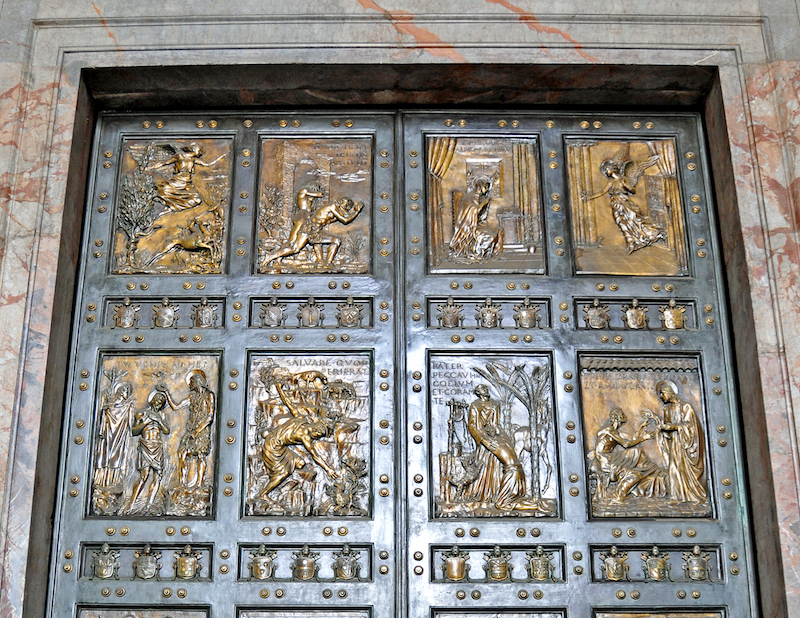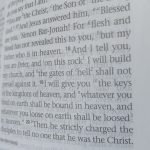On December 8, 2015, Pope Francis opened the enormous bronze Holy Door in Saint Peter’s Basilica to launch the Year of Mercy. Normally cemented shut, the doorway symbolizes entrance into God’s presence where the faithful seek to obtain God’s mercy.
A central feature of the Jubilee Year is the dispensing of plenary indulgences. For many, the word “indulgence” conjures images of the 16th-century relics of Wittenberg, which boasted a sample of the Virgin Mary’s breast milk and a twig from the burning bush. We visualize woodcuts and frescoes depicting a family of languishing souls reaching out through purgatorial flames. We see indulgence preachers traversing the German countryside with wagons full of coins, coffers, and certificates endorsed by the pope. And we think of Martin Luther, who finally stood up and said, “Enough!”
But there is more to the story.
Indulgences and Misunderstandings
In medieval theology, like today, the sacrament of penance required repentant sinners to make satisfaction for their transgressions through spiritual and corporeal works of mercy. This involved saying prayers, serving the poor, giving alms, or going on a pilgrimage. In the year 1095, Pope Urban II decreed that penitents would be released from their obligation to perform these works if they joined the crusade against the Turks. Subsequent popes repeated this provision by offering indulgences on other occasions. In gratitude, the faithful offered financial gifts to the Church.
The custom of transacting indulgences escalated and eventually grew into a significant revenue stream. An inflexion point occurred in 1476 when Pope Sixtus IV issued Salvator Noster, a bull extending penitential satisfaction to deceased individuals for whom an indulgence was offered. So, for example, when Martin Luther visited Rome in 1510–11 and climbed Pilate’s stairway on his knees—the scala sancta, praying on each step—he did so on behalf of his grandfather. Such devotion was commonplace.


The indulgence trade came to a head after Pope Julius II issued a “Jubilee Indulgence” in 1507 to support the construction of the new St. Peter’s Basilica in Rome. Urgency to fund the building project set in motion indulgence preachers who traveled through Europe obtaining money from families who might otherwise have used their coins to purchase shoes for their children. The Protestant Reformation followed, and the rest, as they say, is history.
Catholic reform eventually abolished the sale of indulgences, but the custom of granting them continues to the present, as illustrated by Pope Francis’s Extraordinary Jubilee Year of Mercy, which is set to conclude on November 20, 2016. While there have been numerous developments in canon law concerning indulgences, the underlying logic remains the same.
Finally, to understand indulgences, one must avoid the common error that an indulgence provides forgiveness. According to Catholic teaching, the sacrament of penance ordinarily accomplishes that forgiveness. Indulgences, by contrast, are concerned with addressing the consequences of sin, so-called “temporal punishment.” In the words of the Catholic Catechism:
An indulgence is a remission before God of the temporal punishment due to sins whose guilt has already been forgiven, which the faithful Christian who is duly disposed gains under certain prescribed conditions through the action of the Church which, as the minister of redemption, dispenses and applies with authority the treasury of the satisfactions of Christ and the saints. (Catechism of the Catholic Church, 1471)
Obtaining Indulgences Today
How does one go about obtaining an indulgence today? In order to extend this mercy to as many of the Catholic faithful as possible during the Year of Jubilee, the Church has opened a Holy Door of Mercy in every Catholic cathedral and at major pilgrimage sites throughout the world. Importantly, the indulgence obtained by passing through a Holy Door is a plenary indulgence—the full remission of all temporal punishment due to sin.
If this sounds easy—what’s the big deal about walking through a designated door in a church?—the process of securing a plenary indulgence is much more extensive. There are four prerequisites to obtaining such an indulgence (the following are the instructions found at the entrance to the Holy Door of the Basilica della Madonna di San Luca, Bologna, Italy):
(1) pray (the Creed, the Our Father, the Hail Mary, the Gloria . . .) and for the [prayer] intentions of the Holy Father; (2) within fifteen days, approach the sacrament of Penance, confessing one’s sins, and participate in the Mass, taking Holy Communion; (3) have the inner attitude of actual and affective separation from every sin, not only grave and mortal, but also slight and venial; (4) engage in a work of mercy, whether corporeal or spiritual.
Once a faithful Catholic has met these prerequisites, being in state of grace, she can approach and walk through a Holy Door. She thereby obtains a plenary Jubilee indulgence for herself or for the sake of the souls of her deceased relatives or friends in purgatory. This indulgence may be secured once a day, and it lasts for the entire day.
Prayer. Penance. The Eucharist. Separation from sin. Good works. If this way of finding the mercy of God sounds complex, there is another, more excellent way.
Gospel of Mercy
Following his visit to Rome, in which he had passed through a host of sacred doorways, Martin Luther began to reflect more deeply on the question of how one obtains divine mercy. By 1517, Luther’s answer was coming into focus. On the eve of All Saints Day he approached yet another door—the door of the Castle Church in Wittenberg—whereupon he posted his list of 95 Theses. Among them was number 62: “The true treasure of the Church is the Most Holy Gospel of the glory and the grace of God.” Concerning this gospel discovery, Luther would later describe it as a door of mercy:
Night and day I pondered until I saw the connection between the justice of God and the statement that “the just shall live by his faith.” Then I grasped that the justice of God is that righteousness by which through grace and sheer mercy God justifies us through faith. Thereupon I felt myself to be reborn and to have gone through open doors into paradise. The whole of Scripture took on a new meaning, and whereas before the “justice of God” had filled me with hate, now it became to me inexpressibly sweet in greater love. This passage of Paul became to me a gate to heaven.
Nearly 500 years after Luther’s Theses, his insight into divine mercy continues to animate evangelical faith. The divine doorway is narrow, but it remains open to all—and is always open—for those who are in Christ. Even after November 20, when the Vatican has once again cemented the bronze doors of Saint Peter’s Basilica, Christians are invited to approach the Father without hesitation or impediment, on account of Christ’s perfect righteousness in which we are clothed.
Editors’ note: Chris Castaldo and Gregg Allison are co-authors of a new book on this topic, The Unfinished Reformation: What Unites and Divides Catholics after 500 Years (Zondervan). We also invite you to join us April 3-5, 2017, for TGC’s national conference, “No Other Gospel: Reformation 500 and Beyond.”
Is there enough evidence for us to believe the Gospels?










































